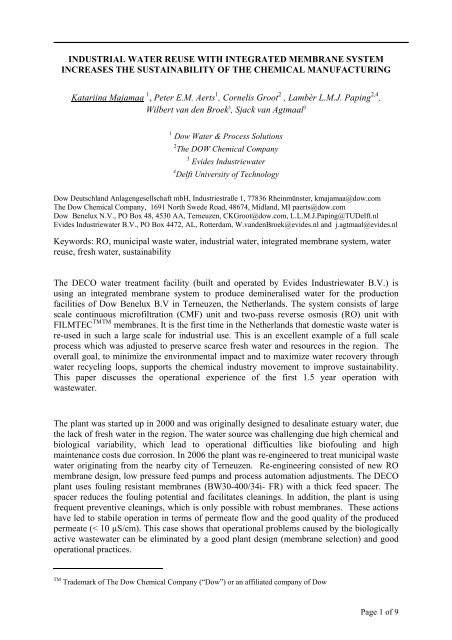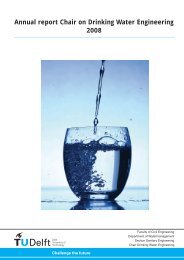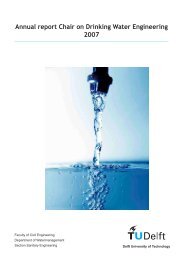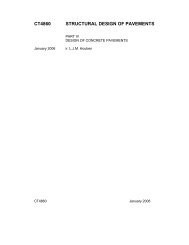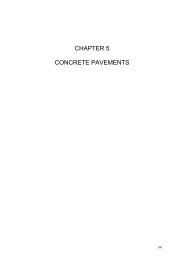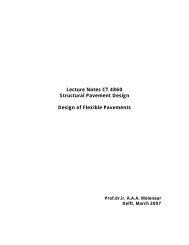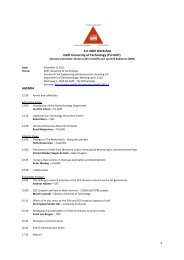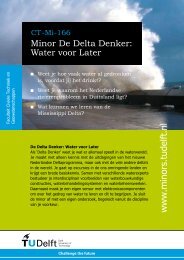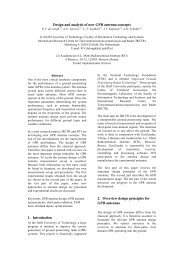industrial water reuse with integrated membrane system
industrial water reuse with integrated membrane system
industrial water reuse with integrated membrane system
Create successful ePaper yourself
Turn your PDF publications into a flip-book with our unique Google optimized e-Paper software.
INDUSTRIAL WATER REUSE WITH INTEGRATED MEMBRANE SYSTEM<br />
INCREASES THE SUSTAINABILITY OF THE CHEMICAL MANUFACTURING<br />
Katariina Majamaa 1 , Peter E.M. Aerts 1 , Cornelis Groot 2 , Lambèr L.M.J. Paping 2,4 ,<br />
Wilbert van den Broek 3 , Sjack van Agtmaal 3<br />
1 Dow Water & Process Solutions<br />
2 The DOW Chemical Company<br />
3 Evides Industrie<strong>water</strong><br />
4 Delft University of Technology<br />
Dow Deutschland Anlagengesellschaft mbH, Industriestraße 1, 77836 Rheinmünster, kmajamaa@dow.com<br />
The Dow Chemical Company, 1691 North Swede Road, 48674, Midland, MI paerts@dow.com<br />
Dow Benelux N.V., PO Box 48, 4530 AA, Terneuzen, CKGroot@dow.com, L.L.M.J.Paping@TUDelft.nl<br />
Evides Industrie<strong>water</strong> B.V., PO Box 4472, AL, Rotterdam, W.vandenBroek@evides.nl and j.agtmaal@evides.nl<br />
Keywords: RO, municipal waste <strong>water</strong>, <strong>industrial</strong> <strong>water</strong>, <strong>integrated</strong> <strong>membrane</strong> <strong>system</strong>, <strong>water</strong><br />
<strong>reuse</strong>, fresh <strong>water</strong>, sustainability<br />
The DECO <strong>water</strong> treatment facility (built and operated by Evides Industrie<strong>water</strong> B.V.) is<br />
using an <strong>integrated</strong> <strong>membrane</strong> <strong>system</strong> to produce demineralised <strong>water</strong> for the production<br />
facilities of Dow Benelux B.V in Terneuzen, the Netherlands. The <strong>system</strong> consists of large<br />
scale continuous microfiltration (CMF) unit and two-pass reverse osmosis (RO) unit <strong>with</strong><br />
FILMTEC TMTM <strong>membrane</strong>s. It is the first time in the Netherlands that domestic waste <strong>water</strong> is<br />
re-used in such a large scale for <strong>industrial</strong> use. This is an excellent example of a full scale<br />
process which was adjusted to preserve scarce fresh <strong>water</strong> and resources in the region. The<br />
overall goal, to minimize the environmental impact and to maximize <strong>water</strong> recovery through<br />
<strong>water</strong> recycling loops, supports the chemical industry movement to improve sustainability.<br />
This paper discusses the operational experience of the first 1.5 year operation <strong>with</strong><br />
waste<strong>water</strong>.<br />
The plant was started up in 2000 and was originally designed to desalinate estuary <strong>water</strong>, due<br />
the lack of fresh <strong>water</strong> in the region. The <strong>water</strong> source was challenging due high chemical and<br />
biological variability, which lead to operational difficulties like biofouling and high<br />
maintenance costs due corrosion. In 2006 the plant was re-engineered to treat municipal waste<br />
<strong>water</strong> originating from the nearby city of Terneuzen. Re-engineering consisted of new RO<br />
<strong>membrane</strong> design, low pressure feed pumps and process automation adjustments. The DECO<br />
plant uses fouling resistant <strong>membrane</strong>s (BW30-400/34i- FR) <strong>with</strong> a thick feed spacer. The<br />
spacer reduces the fouling potential and facilitates cleanings. In addition, the plant is using<br />
frequent preventive cleanings, which is only possible <strong>with</strong> robust <strong>membrane</strong>s. These actions<br />
have led to stabile operation in terms of permeate flow and the good quality of the produced<br />
permeate (< 10 µS/cm). This case shows that operational problems caused by the biologically<br />
active waste<strong>water</strong> can be eliminated by a good plant design (<strong>membrane</strong> selection) and good<br />
operational practices.<br />
TM Trademark of The Dow Chemical Company (“Dow”) or an affiliated company of Dow<br />
Page 1 of 9
The facility reports significant savings, 20 % increase in the <strong>system</strong> recovery and 50 %<br />
reduction in the operational cost (OPEX) <strong>with</strong> the implementation of the waste <strong>water</strong> treated<br />
<strong>system</strong>. The savings in OPEX are mainly related to energy costs and decreased use of<br />
chemicals for <strong>water</strong> treatment. In addition, the environmental impact is reduced as the city’s<br />
waste <strong>water</strong> is no longer discharged to the sea, but given another life as process <strong>water</strong>.<br />
INTRODUCTION<br />
Efficient <strong>water</strong> management is critical for industry sustainability, especially for high <strong>water</strong><br />
consuming ones like the chemical industry. As one of the largest chemical companies in the<br />
world, Dow is committed to constantly improve the efficiency of <strong>water</strong> management in its<br />
own facilities. A prime example of this is the large production site in Terneuzen, the<br />
Netherlands, where half of its <strong>water</strong> demand is met via recycled <strong>water</strong> streams, process <strong>water</strong><br />
and rain <strong>water</strong> [1]. The Zeeuws-Vlaanderen region where the site is located lacks a fresh<br />
<strong>water</strong> source and thus <strong>water</strong> management has been essential since the beginning of the<br />
operations [2]. The most recent step towards sustainable <strong>water</strong> management was taken when<br />
municipal waste <strong>water</strong> effluent originating from city of Terneuzen replaced the Westerschelde<br />
estuary <strong>water</strong> as a source for process <strong>water</strong>.<br />
Dow has outsourced the <strong>water</strong> utilities to Evides Industrie<strong>water</strong>, the largest supplier of<br />
<strong>industrial</strong> <strong>water</strong> in the Netherlands. The various <strong>water</strong> needs of the manufacturing site are<br />
answered by the DECO (=demin and cooling <strong>water</strong>) treatment facility. The facility produces<br />
demineralised (demin) <strong>water</strong> (750 m 3 /h), cooling tower supply <strong>water</strong> (750 m 3 /h) and ultrapure<br />
<strong>water</strong> (1 200 m 3 /h) <strong>with</strong> various technologies, including Integrated Membrane System (IMS),<br />
ion exchange resins and multimedia filters from various feed <strong>water</strong> sources, as shown in<br />
Figure 1 [1,3].<br />
DOW<br />
1050 m3/h<br />
plants Polished<br />
Waste<br />
<strong>water</strong><br />
WWTP<br />
WWTP WZV<br />
Polished<br />
<strong>water</strong><br />
Condensate<br />
return<br />
Cooling Tower Supply<br />
<strong>water</strong> 400-650 m3/h<br />
<strong>water</strong><br />
plant<br />
Demin <strong>water</strong><br />
600-750 m3/h<br />
BIOX <strong>water</strong><br />
0-500 m3/h<br />
DECO plant<br />
Effluent <strong>water</strong><br />
550-600 m3/h<br />
BB surface<br />
<strong>water</strong> 500-800<br />
m3/h<br />
Fresh <strong>water</strong><br />
700 m3/h<br />
WTP<br />
Braakman<br />
Figure 1 Overview of <strong>water</strong> flows<br />
Since the year 2000, reverse osmosis <strong>membrane</strong>s have been used to produce part of the demin<br />
<strong>water</strong>, which is used for generating steam and to feed manufacturing plants. The IMS consists<br />
Page 2 of 9
of a continuous microfiltration unit (CMF) and a two-pass reverse osmosis (RO) unit <strong>with</strong><br />
FILMTEC <strong>membrane</strong>s. The facility was originally designed to desalinate estuary <strong>water</strong>, but<br />
the primary disadvantage of the sea<strong>water</strong> was its inconsistency. The Westerschelde estuary is<br />
very dynamic <strong>with</strong> varying seasonal <strong>water</strong> quality, in both chemical and biological terms. In<br />
addition, the <strong>water</strong> shows considerable fluctuations in suspended solids load due to the tides<br />
and the nature of the <strong>water</strong> intake (next to a harbor dock <strong>with</strong> incoming and outgoing ships<br />
and barges). This led to operational challenges such as biofouling and high maintenance costs<br />
due to corrosion and the partners decided to evaluate alternative feed <strong>water</strong> sources [3,4]. In<br />
2006, the plant was re-engineered to treat municipal waste<strong>water</strong> effluent originating from the<br />
households of 55,000 inhabitants in the Terneuzen city. This paper discusses the operational<br />
experience of the first 1.5 year operation <strong>with</strong> treated municipal waste<strong>water</strong>.<br />
IMS RETROFIT FROM SEAWATER FEED TO EFFLUENT FEED<br />
The process flow diagram of the retrofitted <strong>system</strong> is presented in the Figure 2. The effluent<br />
from the waste <strong>water</strong> treatment plant is transported via 7 km pipeline to a storage tank (1,500<br />
m 3 ) in order to minimize the hydraulic load variations during night time. At the same time,<br />
the <strong>water</strong> can be disinfected <strong>with</strong> sodium hypochlorite (NaOCl) and ammonium salt (NH4Cl)<br />
to reduce the biofouling risk in the IMS. From the storage tank, the <strong>water</strong> is transferred to<br />
DECO site via another 7 km of pipeline.<br />
Upon arrival to the facility, the pH can be adjusted <strong>with</strong> sulfuric acid (H2SO4) prior feeding it<br />
to the CMF units. There are in total 8 units, from which 7 are in operation. The hardware<br />
remained unchanged in the retrofit, but the operation was adjusted for waste <strong>water</strong> by<br />
reducing the operation flux.<br />
There are two RO units in place and the configuration is as follows: 28:16 pressure vessels in<br />
the first pass and 16:6 pressure vessels in the second pass. Each pressure vessel is housing 6<br />
standard 8” elements (in total 792). The design capacity of each RO unit is 150-175 m 3 /h.<br />
Antiscalant (Genesys LF) is dosed at concentration of 3.5 mg/l prior to RO. The SWRO units<br />
in the first pass were re-engineered to low pressure RO units. This included changing the feed<br />
pumps to low pressure pumps and the RO <strong>membrane</strong>s to brackish <strong>water</strong> <strong>membrane</strong>s. In<br />
addition, modifications were done in process automation. The second pass of the RO units<br />
remained same as <strong>with</strong> the SWRO <strong>system</strong>.<br />
The selected brackish <strong>water</strong> <strong>membrane</strong> was a fouling resistant <strong>membrane</strong> (BW30-400/34i-<br />
FR), which unique surface chemistry increases the resistance against biofilm build up while<br />
providing constant salt rejection. The <strong>membrane</strong> is packed into element <strong>with</strong> wide (34 mil)<br />
feed spacer which lessens even further the impact of the fouling and enhances the cleaning<br />
effectiveness.<br />
The permeate of the IMS <strong>system</strong> is mixed <strong>with</strong> demineralised <strong>water</strong> produced in the ion<br />
exchange <strong>system</strong> and then finally supplied to Dow. The concentrate of the <strong>integrated</strong><br />
<strong>membrane</strong> <strong>system</strong> is mixed and directly discharged to the Westerschelde.<br />
Page 3 of 9
Figure 2 Process flow diagram of the retrofitted <strong>system</strong><br />
Table<br />
1 is a comparison of the <strong>water</strong> quality from two feed sources: sea <strong>water</strong> and waste<br />
<strong>water</strong>. The primary disadvantage <strong>with</strong> the sea <strong>water</strong> was its inconsistency. In contrast, the<br />
effluent of the community waste <strong>water</strong> treatment plant (WWTP) is very consistent in quality.<br />
The average effluent <strong>water</strong> quality is controlled according to discharge standards for surface<br />
<strong>water</strong> to the Westerschelde. The inlet <strong>water</strong> quality is strictly monitored and in case of offspec<br />
effluent, the <strong>membrane</strong> units can use fresh surface <strong>water</strong> as feed <strong>water</strong> [3].<br />
Table 1 Feed <strong>water</strong> analysis<br />
Unit Sea Water WWTP Effluent<br />
Temperature °C 25 13.5<br />
pH — 8.1 7.1<br />
Na m g/L 7,123<br />
300<br />
Sulfate mg/L 1,546 100<br />
Chloride mg/L 12,820 480<br />
Total phosphate mg/L 0.12 0.5<br />
Ammonia mg/L 0.22 8.0<br />
Chemical oxygen demand (COD) mg/L N/A 50<br />
Total organic content (TOC) mg/L 2.2 9.8<br />
Total dissolved solids (TDS) mg/L 18,000 1,200<br />
Total suspended solids (TSS) mg/L 20 5.4<br />
In order to highlight the benefits of the retrofit, the main operational parameters of the first<br />
pass RO <strong>with</strong> sea <strong>water</strong> (SWRO) and effluent <strong>water</strong> (EWRO) are presented in the Table 2.<br />
The presented data are design values derived from the computer simulation (ROSA). The<br />
simulations were done by using the TDS and temperature given in the raw <strong>water</strong> analysis<br />
(Table 1 ) and in both cases, the <strong>system</strong> was simulated <strong>with</strong> new <strong>membrane</strong>s to allow a direct<br />
Page 4 of 9
comparison. The main benefits are the increased <strong>system</strong> recovery and the decreased energy<br />
consumption.<br />
Table 2 Main design parameters of the first pass RO before and after retrofit<br />
Operation parameter SWRO EWRO<br />
Flux (l/m 2 /h) 20.99 20.99<br />
Recovery 54.99 75<br />
Raw Water Flow to <strong>system</strong> (m 3 /h) 343.50 243.64<br />
Feed pressure (bar) 40.77 13.49<br />
Specific Energy (kWh/m 3 ) 2.57 0.62<br />
Permeate quality, TDS (mg/l) 92.02 10.85<br />
System Recovery (%) 50.95 71.84<br />
PLANT<br />
PERFORMANCE WITH EFFLUENT WATER<br />
A successful operation of a <strong>membrane</strong> plant requires the combination<br />
of good plant design<br />
and good operational practices. Due the natural tendency of waste <strong>water</strong>, the feed <strong>water</strong> is still<br />
biologically active and the combination is needed in order to eliminate operational problems<br />
caused by biofouling.<br />
The variations in the effluent <strong>water</strong> temperature and salinity (conductivity) during the first 1.5<br />
year of operation are presented in the Figure 3. The temperature shows seasonal variations<br />
from 8 ºC in the winter to 20 ºC in the summer time, but the variation is smaller than it was<br />
<strong>with</strong> sea <strong>water</strong> where temperatures could range from 15-33ºC [4]. Similarly, the effluent<br />
conductivity varies between 1000-2500 µS/cm whereas sea <strong>water</strong> could range between 25000<br />
and 40 000 µS/cm and changes could occur in couple of days [4].<br />
Temperature (ºC)<br />
20<br />
18<br />
16<br />
14<br />
12<br />
10<br />
8<br />
6<br />
4<br />
2<br />
0<br />
1-Mar-07<br />
30-Apr-07<br />
29-Jun-07<br />
28-Aug-07<br />
Temperature (ºC) Conductivity (µS/cm)<br />
27-Oct-07<br />
26-Dec-07<br />
24-Feb-08<br />
24-Apr-08<br />
23-Jun-08<br />
22-Aug-08<br />
Figure 3 Feed <strong>water</strong> temperature and salinity variations<br />
6000<br />
5000<br />
4000<br />
3000<br />
2000<br />
1000<br />
0<br />
Page 5 of 9
As no hardware changes were done in the CMF unit, it continues to be the bottleneck<br />
of the<br />
operation as previously explained by Agtmaal et al. [3]. The low operational capacity of the<br />
CMF<br />
unit allows only one RO unit to run at a time. The units are alternated on daily basis<br />
(one day off/one day on).<br />
The performance of the RO units are monitored via normalized permeate flow, normalized<br />
salt passage and feed to concentrate<br />
pressure drop. The normalized permeate flow together<br />
<strong>with</strong><br />
the cleaning in place (CIP) activities for one skid is shown in Figure 4. Regardless of the<br />
high fouling tendency of the waste <strong>water</strong>, the permeate flow has remained at sustainable level<br />
and the feed to concentrate pressure drop (Δp), shown in the Figure 5, has also remained<br />
stable. The data illustrates the importance of correct operational practices. Evides has taken<br />
the proactive approach <strong>with</strong> preventive cleanings combined <strong>with</strong> regular maintenance<br />
cleanings to avoid irreversible loss in the performance. This has proven to be very successful<br />
tactic. Frequent cleanings are often expected to reduce the life span of some <strong>membrane</strong>s. The<br />
critical factor to <strong>with</strong>stand frequent cleanings is the robustness of the <strong>membrane</strong> and the<br />
correctly performed CIPs, not exceeding the general guidelines given by the <strong>membrane</strong><br />
manufacturers. The operational data show no evidence on performance decline due the<br />
cleanings. The normalized salt rejection has been maintained very stable between 98 and 99%<br />
throughout the operation period (Figure 6).<br />
Normalized Permeate Flow (m3/h)<br />
200<br />
180<br />
160<br />
140<br />
120<br />
100<br />
80<br />
60<br />
40<br />
20<br />
0<br />
1-Mar-07<br />
30-Apr-07<br />
29-Jun-07<br />
28-Aug-07<br />
Permeate Flow (m3/h) CIP<br />
27-Oct-07<br />
26-Dec-07<br />
24-Feb-08<br />
24-Apr-08<br />
Figure 4 Normalized permeate flow of skid 1<br />
23-Jun-08<br />
22-Aug-08<br />
Page 6 of 9
Differential pressure (bar)<br />
Normalized Salt Rejection (%)<br />
4.0<br />
3.5<br />
3.0<br />
2.5<br />
2.0<br />
1.5<br />
1.0<br />
0.5<br />
0.0<br />
1-Mar-07<br />
100.0%<br />
98.0%<br />
96.0%<br />
94.0%<br />
92.0%<br />
90.0%<br />
1-Mar-07<br />
30-Apr-07<br />
30-Apr-07<br />
29-Jun-07<br />
29-Jun-07<br />
28-Aug-07<br />
System differential pressure CIP<br />
27-Oct-07<br />
26-Dec-07<br />
24-Feb-08<br />
24-Apr-08<br />
Figure 5 Differential pressure of skid 1<br />
28-Aug-07<br />
Rejection % CIP<br />
27-Oct-07<br />
26-Dec-07<br />
24-Feb-08<br />
24-Apr-08<br />
Figure 6 Normalized Salt Rejection of skid 1<br />
23-Jun-08<br />
23-Jun-08<br />
22-Aug-08<br />
22-Aug-08<br />
In the operation of the RO units, the feed <strong>water</strong> change has been positive as the performance<br />
has been good over the first 1.5 years. When compared to SW feed, the plant recovery has<br />
increased by 20 %, which corresponds to saving in <strong>water</strong> intake of 3 million m 3 /a. On an<br />
Page 7 of 9
economical basis, the facility reports operation savings up to 50 %, caused by lower energy<br />
need (reduced by 5,000 MWh/a) and reduced amount of operational chemicals (500 ton/a).<br />
Further modifications to the <strong>system</strong> are planned in order to increase the output of the plant as<br />
well as to meet the stricter environmental European surface <strong>water</strong> quality objective for<br />
regional <strong>water</strong>s [2]. Based on a successful pilot trial, a <strong>membrane</strong> bioreactor (MBR) will be<br />
implemented in the Terneuzen WWTP. This will increase the total output of the WWTP and<br />
deliver a better permeate quality compared to the current CMF permeate as the pilot has<br />
shown [5]. Therefore, the CMF units will be removed at the end of 2009 and the MBR<br />
permeate will be directly used as feed <strong>water</strong> to RO.<br />
AWARDS<br />
The <strong>water</strong> treatment <strong>system</strong> described here represents the first time in the Netherlands that<br />
domestic waste <strong>water</strong> has been recycled on a large scale for <strong>industrial</strong> use. The initiative has<br />
been rewarded the Environmental Award 2007 of the Province of Zeeland (Zeeuwse<br />
Milieuprijs), the Dutch VNCI Responsible Care Award 2007, the European Cefic Responsible<br />
Care Award 2007, the ICIS Innovation Award 2008 for the Most Innovative Corporate Social<br />
Responsibility Project, and an IChemE <strong>water</strong> award.<br />
SUMMARY AND CONCLUSIONS<br />
The case story presented here has shown that a municipal waste <strong>water</strong> effluent can be<br />
successfully <strong>reuse</strong>d for <strong>industrial</strong> purposes and that existing treatment units can be converted<br />
to <strong>reuse</strong> waste <strong>water</strong>s in cases where <strong>water</strong> treatment facilities are in close vicinity to each<br />
other. The DECO plant is an excellent example of a full scale <strong>industrial</strong> process which was<br />
adjusted to preserve scarce fresh <strong>water</strong> resources and the successful experience of the plant<br />
can be leveraged to other similar locations.<br />
The DECO facility reports significant savings, 20 % increase in the <strong>system</strong> recovery and 50 %<br />
reduction in the operational cost <strong>with</strong> the implementation of the waste <strong>water</strong> treated <strong>system</strong>.<br />
The savings in OPEX are mainly related to energy costs and decreased use of chemicals. In<br />
addition, the environmental impact is reduced as the city’s waste <strong>water</strong> is no longer<br />
discharged to the sea, but given another life as process <strong>water</strong>.<br />
By maximizing <strong>water</strong> recovery via <strong>water</strong> recycling loops, sustainable chemical manufacturing<br />
can be achieved, <strong>with</strong> less impact on the environment and more <strong>water</strong> available for non<strong>industrial</strong><br />
uses. The installation of this waste <strong>water</strong> treatment <strong>system</strong> is in line <strong>with</strong> Dow’s<br />
2015 Sustainability Goals, recognizing that sustainable <strong>water</strong> management is good for<br />
communities and the environment and can generate cost savings.<br />
Page 8 of 9
REFERENCES<br />
1. Groot, C.K., Paping, L.L.M.J., Miert, L.J., Houwelingen, C. van, Slagt, J., & Boks,<br />
P.A. de (2007). Sustainable <strong>water</strong> management at an <strong>industrial</strong> complex. 6th IWA<br />
specialist conference on waste<strong>water</strong> reclamation and <strong>reuse</strong> for sustainability,<br />
Antwerpen, October 2007 (pp. 1-8). London: IWA.<br />
2. Paping, L.L.M.J., Boks, P.A. de, Agtmaal, J. van, Groot, C.K., Veraart, A.M.J., Brons,<br />
H., & Mourik, J. van (2009) New challenges <strong>with</strong> the industry, 61th Vakantiecursus<br />
<strong>water</strong> mgt, Delft University of Technology, januari 2009 (pp. 67 -89).<br />
3. Agtmaal, J van, Boks, PA de, Cornips, R, & Paping, L.L.M.J., (2007). Evaluation of<br />
feed <strong>water</strong> sources and retrofitting of an Integrated Membrane System., 6th IWA<br />
specialist conference on waste<strong>water</strong> reclamation and <strong>reuse</strong> for sustainability,<br />
Antwerpen, October 2007 (pp. 1-8). London: IWA.<br />
4. Agtmaal, J van, Huiting, H, Boks, PA de, & Paping, L.L.M.J., (2007). Four years of<br />
practical experience <strong>with</strong> an Integrated Membrane System (IMS) treating estuary<br />
<strong>water</strong>. Desalination, 205, (2007) 26-37.<br />
5. Pot, M.A., Agtmaal, J. van, Boks, P.A. de, Veraart, A.M.J., & Schonewille H., Airlift<br />
MBR at municipal WWTP Terneuzen – pilot research supports full scale<br />
implementation, MBR-Network workshop Berlin 2009<br />
Page 9 of 9


